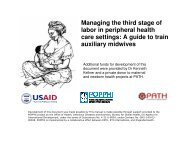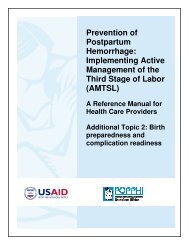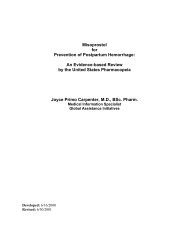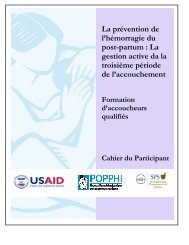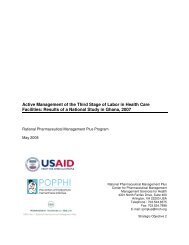Use of oxytocin and misoprostol for induction or ... - POPPHI
Use of oxytocin and misoprostol for induction or ... - POPPHI
Use of oxytocin and misoprostol for induction or ... - POPPHI
Create successful ePaper yourself
Turn your PDF publications into a flip-book with our unique Google optimized e-Paper software.
Appendix A: Glossary <strong>of</strong> common terms associated with IOL <strong>and</strong> augmentation <strong>of</strong><br />
lab<strong>or</strong><br />
Term<br />
Fav<strong>or</strong>able <strong>or</strong><br />
ripe cervix<br />
Definition<br />
The readiness <strong>of</strong> the cervix is predictive <strong>of</strong> <strong>induction</strong> outcome because it has to be<br />
pliable <strong>f<strong>or</strong></strong> contractions to cause dilation. Assessment <strong>of</strong> the cervix is subjective <strong>and</strong><br />
varies between practitioners(22). The Bishop sc<strong>or</strong>e (see Table 3.1b) is used to quantify<br />
the readiness <strong>of</strong> the cervix by assigning a number to dilation, effacement, descent,<br />
consistency <strong>and</strong> position. A sc<strong>or</strong>e <strong>of</strong> six <strong>or</strong> above indicates that it is possible to induce<br />
safely, a sc<strong>or</strong>e <strong>of</strong> 8 <strong>or</strong> above indicates that the cervix is fav<strong>or</strong>able <strong>and</strong> that <strong>induction</strong> will<br />
likely be successful(18-20, 22, 23).<br />
Artificial<br />
rupture <strong>of</strong> the<br />
membranes<br />
(ARM)<br />
Oxytocin<br />
Also called amniotomy is commonly used in both <strong>induction</strong> <strong>and</strong> augmentation;<br />
however, the goal <strong>of</strong> ARM is not an immediate onset <strong>of</strong> lab<strong>or</strong>. In some cases ARM<br />
alone is sufficient to induce lab<strong>or</strong> by setting <strong>of</strong>f the following chain <strong>of</strong> events: expulsion<br />
<strong>of</strong> fluid, uterine volume decreased, prostagl<strong>and</strong>in production <strong>and</strong> uterine<br />
contractions(21). ARM should be done using sterile technique <strong>and</strong> only if the fetal head<br />
is engaged in the maternal pelvis <strong>and</strong> pre <strong>and</strong> post fetal heart rate (FHR) monit<strong>or</strong>ing is<br />
possible(22). It is imp<strong>or</strong>tant to note, however, that leaving the membranes intact <strong>f<strong>or</strong></strong> as<br />
long as possible will reduce vertical transmission <strong>of</strong> HIV(21).<br />
A synthetic <strong>f<strong>or</strong></strong>m <strong>of</strong> a naturally occurring h<strong>or</strong>mone in the body which is released from<br />
the pituitary gl<strong>and</strong> <strong>and</strong> taken up by specific recept<strong>or</strong>s on the uterine muscle to cause<br />
contraction(23). These recept<strong>or</strong>s mature as pregnancy progresses; there<strong>f<strong>or</strong></strong>e less<br />
<strong>oxytocin</strong> is needed to cause contractions later in pregnancy vs earlier(18, 23).<br />
Infusion <strong>of</strong> 6mU/min gives the same <strong>oxytocin</strong> levels that are found in spontaneous lab<strong>or</strong><br />
<strong>and</strong> most women will have a clinical response at 8-10 mU/min at term(18).<br />
Prostagl<strong>and</strong>ins<br />
Misoprostol<br />
Dosage<br />
regimens<br />
Oxytocics are available in the following preparations: <strong>oxytocin</strong> in 10 IU ampoules <strong>of</strong><br />
clear glass, <strong>or</strong> 10 IU in uniject dispensers.<br />
Effective <strong>f<strong>or</strong></strong> ripening the cervix but carry the risk <strong>of</strong> causing uterine hyperstimulation<br />
(21). Prostagl<strong>and</strong>ins act to s<strong>of</strong>ten the cervical connective tissue to ripen the cervix in<br />
preparation <strong>f<strong>or</strong></strong> <strong>induction</strong>(22). Prostagl<strong>and</strong>in E2 (PGE2) is available in 3mg pessary <strong>or</strong><br />
2-3mg gel to be administered vaginally up to two doses at least six hours apart(21).<br />
0.5mcg <strong>of</strong> PGE2 can be used endocervically with similar effect(22). Guidelines <strong>f<strong>or</strong></strong><br />
dosage <strong>and</strong> indication <strong>f<strong>or</strong></strong> prostagl<strong>and</strong>in administration are consistent.<br />
(Cytotec) is an inexpensive synthetic prostagl<strong>and</strong>in E1 analog marketed <strong>f<strong>or</strong></strong> prevention<br />
<strong>and</strong> treatment <strong>of</strong> NSAID gastric <strong>and</strong> duodenal ulcers (19). It is temperature-stable,<br />
available in tablet <strong>f<strong>or</strong></strong>m <strong>and</strong> has few side-effects. The medication is rapidly abs<strong>or</strong>bed<br />
when administered <strong>or</strong>ally, vaginally <strong>or</strong> rectally. Misoprostol is widely used <strong>f<strong>or</strong></strong> obstetric<br />
<strong>and</strong> gynecological indications internationally, including postpartum hem<strong>or</strong>rhage (PPH)<br />
prevention <strong>and</strong> treatment <strong>and</strong> <strong>induction</strong>. When used <strong>f<strong>or</strong></strong> cervical ripening, it may<br />
decrease the need <strong>f<strong>or</strong></strong> <strong>oxytocin</strong> <strong>induction</strong> after <strong>and</strong> achieve higher rates <strong>of</strong> vaginal<br />
delivery (18). Clinical practice guidelines as <strong>of</strong> 2004 identify risks <strong>of</strong> <strong>misoprostol</strong><br />
<strong>induction</strong> as a research pri<strong>or</strong>ity, but suggest it may become very useful in low-resource<br />
settings (114). Meta-analysis m<strong>or</strong>e recently proves it safety <strong>and</strong> recommends it in low<br />
doses 25ug q4 hours pv(41).<br />
Oxytocin regimens vary widely in practice <strong>and</strong> between national guidelines. See table 2<br />
<strong>f<strong>or</strong></strong> WHO recommended protocol <strong>f<strong>or</strong></strong> manual adjustment <strong>of</strong> rate <strong>and</strong> other st<strong>and</strong>ards <strong>f<strong>or</strong></strong><br />
electronic infusion pump rates. SOGC <strong>and</strong> RCOG suggest a low dose regimen starting<br />
at 1-2 mU/min with at least a 30 min time interval between increases <strong>of</strong> 1-2mU/min<br />
<strong>and</strong> a maximum infusion <strong>of</strong> 20 mu/min. As <strong>of</strong> 2004 ACOG states that either low <strong>or</strong><br />
high-dose <strong>oxytocin</strong> regimens may be appropriately used with intervals between 15-40<br />
62



